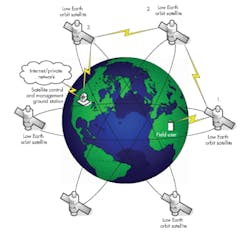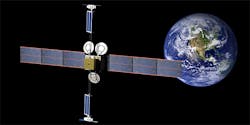Innovations in the small satellite industry have been increasing at a tremendous rate in recent years. This growth can be attributed to exponential increases in technology and the demand for broadband connectivity in remote locations all around the world. Low earth orbit (LEO) and geostationary (GEO) satellites are big players in this skyrocketing industry, and the future for both is looking bright.
Overview of GEO Satellites
Geostationary satellites are earth-orbiting about 22,300 miles (35,800 Kilometers) directly above the equator. They travel in the same direction as the rotation of the Earth. This gives the satellites the ability to stay in one stationary position relative to the Earth. One advantage of GEO satellites is that it is easier to implement new technologies as they arise and additional capacity one satellite at a time, unlike LEO satellites. The disadvantage is that making these improvements is more time-consuming and costly.
Overview of LEO Satellites
Low Earth orbit satellites, like their name implies, orbit much closer to earth. LEOs tend to be smaller in size compared to GEO satellites, but require more LEO satellites to orbit together at one time to be effective. Rather than competing with GEOs, LEOs should be used as more of an accomplice, at least for now (with current technology). It is much cheaper and faster to test new technologies and concepts in LEO devices compared to GEOs.
However, to deliver full communication services over selected locations, more than 1,000 LEO satellites may be needed to achieve sufficient performance. GEO satellites should handle this job for now, but LEO satellites can play a significant role in testing out the new technologies and concepts for GEOs.
Top 7 Elements of GEO and LEO Satellites
As briefly mentioned above, GEO and LEO satellites both have advantages. To choose which is best for a given need, application, or market, it’s important to understand the top factors that play a role in determining how a LEO or GEO will perform for various communication applications.
Here are the top seven criteria you should review when trying to understand LEO and GEO satellite performance:
- Latency
- Coverage
- Efficiency
- Cost
- Complexity
- Frequency spectrum
- Time to market and adaptability
Now, let’s take a quick look at each:
1. Latency
Lower orbits tend to have lower latency for time-critical services because of the closer distance to earth. Latency can many times vary depending on the specific application. Latency is mostly important when looking at online and very interactive applications, such as gaming and electronic services trading. GEO satellite latency typically has limited impact on user experiences. However, with the increase of 4G/LTE and even 5G technology, latency is becoming less of a concern.
2. Coverage
It’s important to reiterate that many LEO satellites must work together to offer sufficient coverage to a given location. Although many LEOs are required, they require less power to operate because they are closer to earth. Choosing to go with more satellites in the LEO orbit on less power, or using fewer larger satellites in GEO, is the biggest decision to make here.
3. Efficiency
Because LEO satellites are constantly moving relative to earth at a given moment, they tend to spend a lot of time over oceans and other unpopulated areas, making them less efficient in that sense. However, this would be the best option when trying to cover a larger geographical area as opposed to GEO satellites. Remember, GEOs stay in one location relative to a specific spot relative to earth. This makes GEOs more efficient for smaller, more specific regions.
4. Cost
Although smaller LEO satellites are less expensive to manufacture, more are typically needed at one time to have effective communication operations. GEO satellites on the other hand are larger with more capability, but are only needed to work successfully in small amounts. In the future, it is expected that new innovations in GEO technology will help to significantly reduce their cost per unit. This not only applies to GEO satellites but the entire satellite industry.
LEO satellites get very complex and expensive when looking at the number of gateways required on the ground to operate. This drives the total cost of the overall system up. However, large-scale production of identical gateways can help reduce these costs.
5. Complexity
As mentioned above, low earth orbiting satellites are more complex when it comes to their expensive ground antennas. The need for many ground satellites comes from the many traveling LEOs in orbit at one time. New phased array antennas can help reduce complexity here, but will need to be used in a wider variety of elevations, which can be difficult to install.
6. Frequency spectrum
LEO satellites are constantly overlapping each other geographically. This makes managing their frequency synchronization complex between systems, because there are many different LEOs traveling all around the world. Managing all these chaotic two-way systems in LEO orbits can become extremely difficult for engineers and operators to allow all the LEO satellites to function without traffic deprivations.
And that’s just the beginning! Things get even more complex with LEOs when they must also coordinate with other GEO satellites at certain points along their orbital journey.
7. Time to market and adaptability
Since a single GEO satellite can cover a specific region, it is much easier to progressively add new satellites to the system or replace old ones. However, when it comes to the many LEO satellites (a LEO constellation) in orbit, a large portion of the constellation will have to be built before adding on to or replacing the current constellation to provide service to a region. Sometimes, the entire LEO constellation will have to be replaced by a new constellation when upgrading performance or implementing alternative services. This adds time, costs, and complexity as opposed to GEOs.
With All That Said…
Innovation and technology improvements are definitely wanted in the future forecast in terms of production, efficiency, costs, and adaptability time, especially for LEOs. We will likely see these innovations in the near future as the demand for availability and quality of services delivered to customers rises and space-based technology continues to develop (all thanks to our super-smart engineers out there, of course!) One day, we hope to see communication services in every location on the planet!
References
- http://www.unidata.com.au/support/technical-white-papers/neon-web-based-technology/
- http://spaceref.biz/company/skycorp/skycorp-introduces-spacecraft-life-extension-system-to-extend-operational-lives-of-geostationary-sat.html
- https://arstechnica.com/information-technology/2016/11/spacex-plans-worldwide-satellite-internet-with-low-latency-gigabit-speed/




